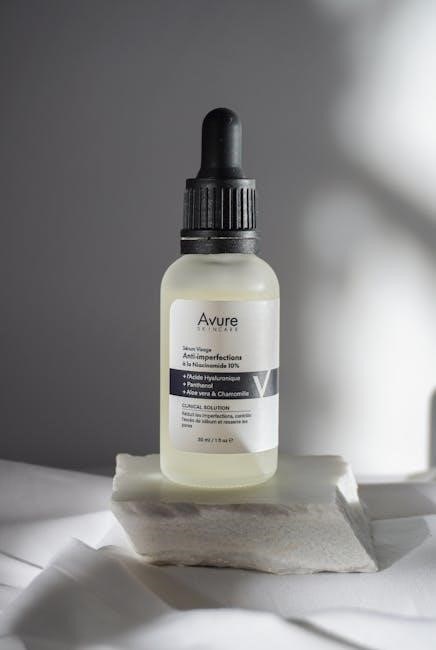
-
By:
- elizabeth
- No comment
interline herbicide label pdf
Product Overview
Interline Herbicide is a non-selective‚ broad-spectrum herbicide containing glufosinate-ammonium‚ effective for controlling annual and perennial weeds in various crops with no soil residual activity․
1․1 Active Ingredient: Glufosinate-Ammonium
Glufosinate-ammonium is the active ingredient in Interline Herbicide‚ classified as a Group 10 herbicide․ It functions as a glutamine synthetase inhibitor‚ disrupting essential amino acid synthesis in plants․ This non-selective‚ broad-spectrum herbicide effectively controls annual and perennial grasses and broadleaf weeds․ Glufosinate-ammonium works through foliar contact‚ with no residual activity in soil‚ making it ideal for targeted weed management․ Its water-soluble formulation ensures rapid uptake and action on emerged‚ actively growing weeds less than 3 inches tall․ The active ingredient is particularly effective in warm‚ humid conditions with bright sunlight‚ enhancing its performance for reliable weed control across various crops․
1․2 Uses and Applications
Interline Herbicide is primarily used for controlling annual and perennial grasses and broadleaf weeds in various crops‚ including cotton‚ Camelina‚ hops‚ and non-crop areas․ It is applied as a foliar spray‚ targeting emerged‚ actively growing weeds less than 3 inches tall․ The herbicide is effective for broadcast burndown applications before planting or crop emergence and for over-the-top weed control in glufosinate-resistant crops․ It is also used in landscape and ornamental settings to manage weeds in specific areas‚ ensuring efficient and reliable weed management across diverse agricultural and non-agricultural environments․
1․3 Mode of Action
Interline Herbicide works by inhibiting glutamine synthetase‚ an enzyme essential for ammonia detoxification in plants․ This action leads to a rapid accumulation of toxic levels of ammonia in plant tissues‚ causing cell death․ The herbicide is foliar-active‚ meaning it must come into contact with the leaves of target weeds to be effective․ It is particularly effective on emerged‚ actively growing weeds‚ with no residual activity in the soil․ This mode of action makes it suitable for controlling a wide range of annual and perennial weeds in various crops and non-crop areas‚ providing efficient weed management without persisting in the environment․

Application Instructions
Interline Herbicide is applied as a foliar spray targeting weeds under 3 inches tall․ It works best in warm‚ humid conditions and bright sunlight․ Suitable for use in both crop and non-crop areas‚ it can be applied via broadcast or directed spray methods to ensure effective weed control․
2․1 General Directions for Use
Interline Herbicide is a foliar-active herbicide with no soil residual activity․ Apply to emerged‚ young‚ actively growing weeds‚ targeting those less than 3 inches tall․ Warm temperatures‚ high humidity‚ and bright sunlight enhance performance․ Use as a broadcast or directed spray‚ ensuring thorough coverage for optimal weed control․ Avoid spraying desirable vegetation or crops not tolerant to glufosinate․ Follow label instructions for specific application rates and guidelines to ensure safe and effective use․
2․2 Tank Mixing Guidelines
Interline Herbicide may be tank-mixed with other herbicides‚ provided the labels of all products allow such mixing․ Always follow the most restrictive label instructions and ensure compatibility․ Test compatibility by mixing small quantities before large-scale use․ Add half the required amount of each product to the tank‚ ensuring the tank is at least half full of water․ Complete filling the tank and add the remaining products․ Maintain constant agitation during mixing and application․ Some products may require specific order of addition or additional surfactants․ Refer to the labels of all products for detailed instructions to ensure chemical stability and efficacy․
2․3 Timing Considerations
Interline Herbicide is most effective when applied to emerged‚ actively growing weeds less than 3 inches in height․ Optimal timing occurs during warm temperatures‚ high humidity‚ and bright sunlight‚ as these conditions enhance herbicide performance․ Apply as a foliar spray‚ ensuring thorough coverage for best results․ For preplant burndown applications‚ apply before crop emergence or planting․ Postemergence applications should target weeds in early growth stages to maximize efficacy․ Avoid application during stressed crop or weed conditions‚ such as drought or extreme temperatures‚ to ensure optimal control․ Timing should also consider crop tolerance and growth stage to prevent unintended damage․

Safety and Handling
Interline Herbicide is a non-selective herbicide containing glufosinate-ammonium․ Handle with care to avoid exposure‚ as it may harm non-target plants․ Follow label instructions precisely to ensure safe use and minimize environmental impact․
3․1 Personal Protective Equipment (PPE)
When handling Interline Herbicide‚ wear long-sleeve shirts‚ long pants‚ closed-toe shoes‚ and chemical-resistant gloves to minimize skin exposure․ Protective eyewear‚ such as goggles‚ is recommended to prevent eye irritation․ A face shield or respirator may be necessary for aerial or high-volume applications․ Ensure all PPE meets EPA and OSHA standards for pesticide application․ Wash clothing thoroughly after use and bathe promptly if skin contact occurs․ Proper PPE use is critical to safeguard against potential health risks associated with herbicide exposure․ Always follow label instructions for specific PPE requirements․
3․2 First Aid Measures
If skin contact occurs‚ immediately remove contaminated clothing and rinse skin with plenty of water for 15-20 minutes․ Call a poison control center or doctor․ For eye exposure‚ flush eyes with water for 15-20 minutes‚ holding the eyelids open․ Seek medical attention if irritation persists; If ingested‚ drink water and do not induce vomiting unless advised by a medical professional․ In case of inhalation‚ move to fresh air and seek medical help if symptoms arise․ For emergencies‚ contact CHEMTREC at 1-800-424-9300․ Follow all first aid instructions carefully to ensure safety and prevent complications․
3․3 Storage and Disposal
Store Interline Herbicide in a cool‚ dry‚ well-ventilated area away from incompatible materials like food‚ feed‚ and seeds․ Keep the container tightly closed and ensure it is out of reach of children and pets․ Dispose of unused product and empty containers according to federal‚ state‚ and local regulations․ Do not reuse containers without proper cleaning and authorization․ For disposal‚ contact your local waste management agency for guidance on hazardous waste disposal․ Always follow all safety precautions and label instructions to ensure safe storage and disposal practices‚ minimizing environmental impact and potential hazards․
Regulatory Information
Interline Herbicide is registered with the EPA under Registration Number 70506-310․ Ensure compliance with all federal‚ state‚ and local regulations for use and application․
4․1 EPA Registration Number: 70506-310
Interline Herbicide is registered with the U․S․ Environmental Protection Agency (EPA) under Registration Number 70506-310․ This number verifies the product’s approval for safe and effective use in controlling weeds across various crops․ The EPA registration ensures compliance with federal standards for pesticide safety‚ environmental impact‚ and human health protection․ Users must adhere to all label instructions and applicable regulations to maintain compliance․ This registration also covers specific labeled crops and usage guidelines‚ ensuring proper application practices․ Always verify state-level registrations‚ as additional requirements may apply․ This EPA registration underscores the product’s reliability for agricultural professionals and farmers․
4․2 Labeled Crops and Usage
Interline Herbicide is labeled for use on a variety of crops‚ including cotton‚ Camelina (false flax)‚ hops‚ and non-crop/industrial areas․ It is specifically approved for broadcast burndown applications prior to planting or crop emergence in labeled row crops․ Additionally‚ it can be applied over-the-top for weed control in glufosinate-resistant crops․ The herbicide is effective for controlling annual and perennial grasses and broadleaf weeds․ Usage is also permitted in landscape and ornamental settings for trimming and edging․ Always refer to the label for specific crop recommendations and application rates to ensure safe and effective use․ Proper application ensures optimal weed control and crop safety․
4․3 State-Level Registrations
Interline Herbicide is registered for use in various states across the U․S․‚ with approvals subject to state-specific regulations․ It is the responsibility of the user to verify state-level registrations before application‚ as local restrictions may apply․ The herbicide’s label includes information on approved uses within each state․ Additionally‚ some states may require special permits or have specific guidelines for application in sensitive areas․ Always check with local authorities to ensure compliance with state regulations․ This ensures safe and legal use of the product‚ protecting both the environment and crops․ Proper adherence to state-level requirements is essential for effective weed management․

Environmental Considerations
Interline Herbicide is water-soluble with no soil residual activity‚ reducing environmental persistence․ Avoid drift into water bodies to protect aquatic life․ Ecotoxicological assessments ensure wildlife protection․
5․1 Ecotoxicological Profile
Interline Herbicide’s ecotoxicological profile indicates potential risks to aquatic organisms․ The active ingredient‚ glufosinate-ammonium‚ can be toxic to fish and aquatic invertebrates if exposure occurs․ Studies show that it may bioaccumulate in certain species‚ posing long-term ecological risks․ Proper application methods and buffer zones are essential to minimize environmental impact․ The herbicide should not be applied near water bodies or during periods of high runoff to protect aquatic ecosystems․ Additionally‚ its effects on non-target terrestrial species‚ such as beneficial insects‚ should be considered to maintain biodiversity and ecosystem health․
5․2 Environmental Fate and Persistence
Interline Herbicide‚ containing glufosinate-ammonium‚ is water-soluble and does not persist in soil due to its lack of residual activity․ It degrades into inert compounds‚ minimizing long-term environmental impact․ The herbicide’s persistence is influenced by soil type‚ moisture‚ and temperature‚ typically breaking down within days to weeks under normal conditions․ However‚ in certain environments‚ such as dry or alkaline soils‚ degradation may slow‚ potentially extending its presence․ Proper application ensures minimal environmental accumulation‚ aligning with its intended use as a foliar-applied herbicide for weed control in agricultural settings․
5․3 Wildlife and Aquatic Protection
Interline Herbicide poses risks to aquatic organisms and wildlife if not used as directed․ Glufosinate-ammonium is moderately toxic to fish and highly toxic to aquatic invertebrates․ To protect aquatic life‚ avoid spraying near water bodies or during rainfall․ Wildlife‚ including birds and mammals‚ may be affected if exposed to treated areas․ Avoid application on or near habitats of non-target species․ Proper buffer zones and adherence to label guidelines minimize ecological risks‚ ensuring the herbicide’s safe and effective use in agricultural settings while safeguarding the environment and wildlife populations․

Supplemental Labels
Supplemental labels for Interline Herbicide provide additional usage guidelines for crops like cotton‚ Camelina‚ hops‚ and non-crop areas‚ ensuring proper application beyond the main label instructions․
6․1 Cotton Application Guidelines
Interline Herbicide’s supplemental label for cotton specifies its use on LibertyLink or glufosinate-tolerant cotton․ It controls emerged weeds like broadleaf and grass species․ Apply as a directed or broadcast spray‚ ensuring proper coverage․ Avoid spraying foliage or green tissue of non-tolerant cotton to prevent injury․ Optimal results occur when weeds are less than 3 inches tall․ Use in warm temperatures with high humidity for enhanced efficacy․ Follow label instructions for rates and timing to ensure crop safety and effective weed control․ This guideline ensures compatibility with glufosinate-resistant cotton varieties‚ making it a reliable choice for weed management in cotton fields․
6․2 Camelina (False Flax) Usage
Interline Herbicide is approved for use on Camelina sativa (false flax) as specified in its supplemental label․ It controls emerged annual and perennial weeds‚ ensuring effective management in Camelina crops․ Apply as a broadcast spray for burndown applications prior to planting or postemergence․ Optimal results occur when targeting weeds less than 3 inches tall․ The herbicide is compatible with Camelina’s growth cycle‚ providing flexibility in application timing․ It offers no soil residual activity‚ making it suitable for rotational cropping systems․ Follow label guidelines for rates and timing to ensure crop safety and maximize weed control efficiency in Camelina production․
6․3 Hops Crop Application
Interline Herbicide is labeled for use in hops to control annual and perennial weeds․ It can be applied as a broadcast spray for burndown applications prior to planting or as a postemergence treatment․ For hops‚ the herbicide should be applied as a directed spray to avoid contact with foliage or green tissue of desirable plants․ It is effective on emerged weeds‚ targeting those less than 3 inches tall for optimal control․ The product’s water-soluble formulation ensures rapid uptake‚ making it a reliable choice for weed management in hop crops․ Always follow label instructions to ensure safe and effective application․
6․4 Non-Crop and Industrial Areas
Interline Herbicide is approved for use in non-crop and industrial areas to control annual and perennial weeds․ It can be applied as a broadcast spray or directed spray for site preparation‚ container yards‚ and industrial sites․ The herbicide is effective for burndown applications and can be used to control weeds in areas like fence rows‚ storage areas‚ and roadsides․ For non-crop use‚ apply to actively growing weeds‚ targeting those less than 3 inches tall for best results․ Avoid spraying desirable vegetation‚ and always follow label instructions to ensure safe and effective application in these areas․

Resistance Management
Interline Herbicide targets glutamine synthetase‚ a Group 10 herbicide mode of action․ Rotate with non-Group 10 herbicides and integrate cultural practices to delay resistance development in weeds․
7․1 Mechanism of Resistance
Resistance to Interline Herbicide occurs when weed populations develop genetic mutations or physiological changes that reduce the herbicide’s effectiveness․ As a Group 10 herbicide‚ Interline inhibits glutamine synthetase‚ an enzyme essential for amino acid synthesis․ Repeated use without rotation can lead to resistance․ Target site mutations‚ enhanced metabolism‚ or altered translocation may contribute․ Monitoring weed populations and integrating diverse control strategies are critical to mitigate resistance development․ Proper management ensures long-term efficacy of Interline Herbicide in weed control programs․
7․2 Strategies to Mitigate Resistance
To mitigate resistance‚ rotate Interline Herbicide with herbicides from different modes of action․ Use recommended rates and apply when weeds are actively growing․ Integrate cultural practices like tillage and crop competition․ Monitor fields for resistant weeds and report findings․ Avoid consecutive applications without rotation․ Employ tank mixes with compatible herbicides when appropriate․ Ensure proper application timing and coverage․ Consider mechanical and biological control methods․ Adhere to label guidelines and regional resistance management plans․ Diversify weed control strategies to delay resistance development and maintain Interline’s effectiveness․

Compatibility with Other Herbicides
Interline Herbicide is compatible with many tank-mix partners when label guidelines are followed․ Proper mixing ensures efficacy and prevents potential crop or application issues․
8․1 Tank Mix Partners
Interline Herbicide is compatible with various tank-mix partners‚ enhancing weed control versatility․ When mixed with other herbicides‚ it maintains efficacy against a broad spectrum of weeds․ Always follow label guidelines to ensure compatibility and avoid antagonism․ Proper mixing procedures and recommended rates must be adhered to for optimal performance․ Tank mixing Interline with complementary herbicides can broaden the range of controlled weeds and improve application efficiency․ However‚ certain combinations may require specific adjustments to maintain crop safety and herbicide effectiveness․ Consult the product label or a qualified agronomist for detailed recommendations on tank-mix partners and application strategies․
8․2 Incompatibility Warnings
Interline Herbicide has specific incompatibilities that must be noted to ensure safe and effective use․ It should not be mixed with products containing calcium‚ magnesium‚ or ammonium ions‚ as this can lead to precipitation․ Additionally‚ mixing with alkaline materials or high-pH substances may reduce efficacy․ Certain surfactants‚ fertilizers‚ and micronutrients are also incompatible and may cause formulation instability․ Always avoid tank mixing with products not explicitly listed on the label․ Improper mixing can result in reduced herbicide performance or equipment damage․ Consult the label for detailed guidelines on compatible tank-mix partners and follow instructions carefully to avoid adverse interactions․
Label Interpretation
Understanding the Interline Herbicide label sections is crucial for proper use․ Key sections include EPA registration‚ active ingredients‚ application rates‚ safety precautions‚ and environmental restrictions․ Always follow instructions․
9․1 Understanding Label Sections
The Interline Herbicide label is divided into key sections for safe and effective use․ The EPA registration number (70506-310) confirms its approval․ The active ingredient‚ glufosinate-ammonium‚ is a Group 10 herbicide․ Application instructions detail rates‚ timing‚ and methods․ Safety data includes PPE requirements and first aid measures․ Environmental sections outline precautions to protect wildlife and water sources․ Supplementary labels provide crop-specific guidance‚ such as for cotton and Camelina․ Always read the label carefully to ensure compliance with regulations and optimal product performance․ Proper interpretation prevents misuse and ensures efficacy while minimizing risks to humans and the environment․
9․2 Compliance and Adherence
Strict compliance with the Interline Herbicide label is essential to ensure safe and effective use․ The label provides legal‚ safety‚ and environmental guidelines that must be followed․ Proper adherence to application rates‚ timing‚ and methods prevents crop damage and environmental harm․ Failure to comply may result in legal consequences‚ reduced efficacy‚ or unintended ecological impacts․ Always verify state-specific registrations and additional restrictions before application․ The EPA registration number (70506-310) guarantees the product meets federal standards․ Users are legally responsible for ensuring all label instructions are followed‚ making it crucial to read and understand the document thoroughly before use․

Emergency Procedures
In case of spills‚ leaks‚ fires‚ or exposure‚ call CHEMTREC at 1-800-424-9300 immediately; Follow first aid measures‚ including flushing skin with water and seeking medical attention if needed․
10․1 Spill Management
In case of a spill‚ immediately contain the area to prevent further contamination․ Use absorbent materials like sand or vermiculite to soak up the liquid․ Avoid using clay-based absorbers․ Neutralize the spill with sodium carbonate solution‚ then flush the area with clean water․ Collect and dispose of all materials in accordance with local regulations․ Do not allow spilled material to enter waterways or drains․ Wear appropriate PPE‚ including gloves‚ goggles‚ and a face mask‚ during cleanup․ Refer to the SDS for detailed handling procedures․ Ensure the area is thoroughly cleaned and ventilated before resuming normal activities․
10․2 Accident Protocols
In the event of an accident involving Interline Herbicide‚ immediately call CHEMTREC at 1-800-424-9300 for emergency assistance․ If skin contact occurs‚ remove contaminated clothing and rinse skin with plenty of water for 15-20 minutes․ In case of eye exposure‚ flush with water for 15 minutes․ If inhaled‚ move the person to fresh air and seek medical attention if irritation persists․ For ingestion‚ do not induce vomiting and contact a poison control center immediately․ Ensure all first aid measures are followed carefully‚ and seek professional medical help without delay․ Keep the product label and SDS accessible for emergency responders․

Specialized Uses
Interline Herbicide is used for burndown applications‚ landscape and ornamental areas‚ and non-crop industrial sites‚ providing effective weed control in specific scenarios beyond standard agricultural use․
11․1 Burndown Applications
Interline Herbicide is effective for broadcast burndown applications prior to planting or crop emergence in labeled row crops․ It controls existing weeds‚ preparing the soil for seeding․ Applied as a foliar spray‚ it targets emerged‚ young‚ actively growing weeds less than 3 inches tall․ Warm temperatures‚ high humidity‚ and bright sunlight enhance its performance․ It is particularly useful in fields where glyphosate-resistant weeds are present‚ offering a reliable alternative for pre-plant weed management․ Always follow label instructions for application rates and timing to ensure optimal results and minimize crop interference․
11․2 Landscape and Ornamental Use
Interline Herbicide is suitable for landscape and ornamental applications‚ controlling weeds in areas like trees‚ shrubs‚ and landscape beds․ It can be used for site preparation and trimming‚ ensuring clean edges․ Directed sprays target weeds without harming desirable plants․ Effective for non-crop areas‚ it provides reliable weed control in ornamental settings‚ enhancing aesthetic appeal․ Follow label guidelines for application rates and methods to achieve optimal results․

Additional Resources
Access the full Interline Herbicide label PDF and Safety Data Sheet (SDS) for detailed application guidelines‚ safety precautions‚ and regulatory information (EPA Reg․ No․ 70506-310)․
12․1 Accessing the Full Label PDF
The full Interline Herbicide label PDF can be accessed through the official UPL website or platforms like Agworld DBX․ This document provides comprehensive details on application rates‚ safety measures‚ and regulatory compliance․ Ensure you review the label before use to adhere to all guidelines and precautions․ Additionally‚ the label is available through authorized distributors and agricultural resources․ Always verify the EPA Registration Number (70506-310) for authenticity․ This resource is essential for understanding proper usage and ensuring safe application practices․
12․2 Safety Data Sheet (SDS)
The Safety Data Sheet (SDS) for Interline Herbicide provides detailed information on its safe handling‚ use‚ storage‚ and disposal․ It includes hazard identification‚ first aid measures‚ and fire-fighting instructions․ The SDS also outlines the herbicide’s composition‚ physical and chemical properties‚ and ecological information․ This document is essential for ensuring the safety of handlers‚ users‚ and the environment․ The SDS for Interline Herbicide (revision date 20-Jan-2022) is available on the UPL website and agricultural databases like Agworld DBX․ Always consult the SDS before handling the product to understand potential hazards and necessary precautions․